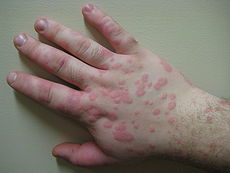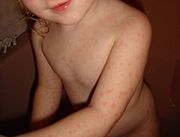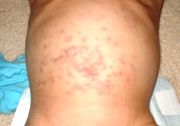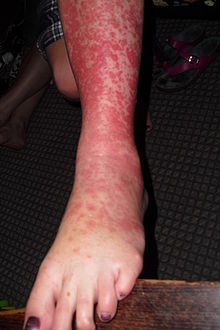- Erythema multiforme
-
Erythema multiforme Classification and external resources
Erythema multiforme minor of the hands ( note the blanching centers of the lesion )ICD-10 L51 ICD-9 695.1 DiseasesDB 4450 MedlinePlus 000851 eMedicine derm/137 MeSH D004892 Erythema multiforme is a skin condition of unknown cause, possibly mediated by deposition of immune complex (mostly IgM) in the superficial microvasculature of the skin and oral mucous membrane that usually follows an infection or drug exposure. It is a common disorder, with peak incidence in the second and third decades of life.
Contents
Presentation
The condition varies from a mild, self-limited rash (E. multiforme minor)[1] to a severe, life-threatening form known as erythema multiforme major (or erythema multiforme majus) that also involves mucous membranes. This severe form may be related to Stevens-Johnson syndrome. The mild form is far more common than the severe form. Diagnosis is confirmed by biopsy.
The mild form usually presents with mildly itchy (but itching can be very severe), pink-red blotches, symmetrically arranged and starting on the extremities. It often takes on the classical "target lesion" appearance,[2] with a pink-red ring around a pale center. Resolution within 7–10 days is the norm.
Individuals with persistent (chronic) erythema multiforme will often have a sore form at an injury site, eg. a minor scratch or abrasion, within a week. Irritation or even pressure from clothing will cause the erythema sore to continue to expand along its margins for weeks or months, long after the original sore at the center heals.
Causes
The most common predisposing infection is Herpes simplex, but bacterial infections (commonly Mycoplasma) and fungal diseases are also implicated. Herpes simplex virus suppression and even prophylaxis (with acyclovir) has been shown to prevent recurrent erythema multiforme eruption.[3] The human form of orf can also cause erythema multiforme.[citation needed]
Other causes include drug reactions, most commonly to sulfa drugs, phenytoin, barbiturates, penicillin, and allopurinol, or a host of internal ailments.
Persistent (chronic) erythema multiforme has been linked to ingestion of benzoates in both natural and artificial forms, including benzoic acid, which occurs naturally in some fruit, and sodium benzoate, a common food preservative.
Treatment
Erythema multiforme is frequently self-limiting and requires no treatment. The appropriateness of glucocorticoid therapy can be uncertain, because it is difficult to determine if the course will be self-limiting.[4]
Erythema multiforme reaction to an antibiotic"Erythema multiforme major" ( Stevens-Johnson syndrome); which resembles "erythema multiforme"Target lesionSee also
- Erythema multiforme major
- Erythema multiforme minor
- Toxic epidermal necrolysis
- Stevens-Johnson syndrome
References
- ^ "erythema multiforme" at Dorland's Medical Dictionary
- ^ Lamoreux MR, Sternbach MR, Hsu WT (December 2006). "Erythema multiforme". Am Fam Physician 74 (11): 1883–8. PMID 17168345. http://www.aafp.org/afp/20061201/1883.html.
- ^ Tatnall FM et al: A double blind plaebo controlled trial of continuous acyclovir therapy in recurrent erythema multiforme. Br J Dermatol132:267,1995
- ^ Yeung AK, Goldman RD (November 2005). "Use of steroids for erythema multiforme in children". Can Fam Physician 51: 1481–3. PMC 1479482. PMID 16353829. http://www.cfp.ca/cgi/pmidlookup?view=long&pmid=16353829.
Urticaria and erythema (L50–L54, 695, 708) Urticaria
(acute/chronic)Allergic urticariaUrticarial allergic eruptionPhysical urticariaCold urticaria (Familial) · Primary cold contact urticaria · Secondary cold contact urticaria · Reflex cold urticariaAquagenic urticariaOther urticariaAcquired C1 esterase inhibitor deficiency · Adrenergic urticaria · Exercise urticaria · Galvanic urticaria · Schnitzler syndrome · Urticaria-like follicular mucinosisErythema Erythema multiforme minor · Erythema multiforme major (Stevens–Johnson syndrome, Toxic epidermal necrolysis) · panniculitis (Erythema nodosum) · Acute generalized exanthematous pustulosisFigurate erythemaOther erythemaNecrolytic migratory erythema · Erythema toxicum · Erythroderma · Palmar erythema · Generalized erythemaThis cutaneous condition article is a stub. You can help Wikipedia by expanding it.





